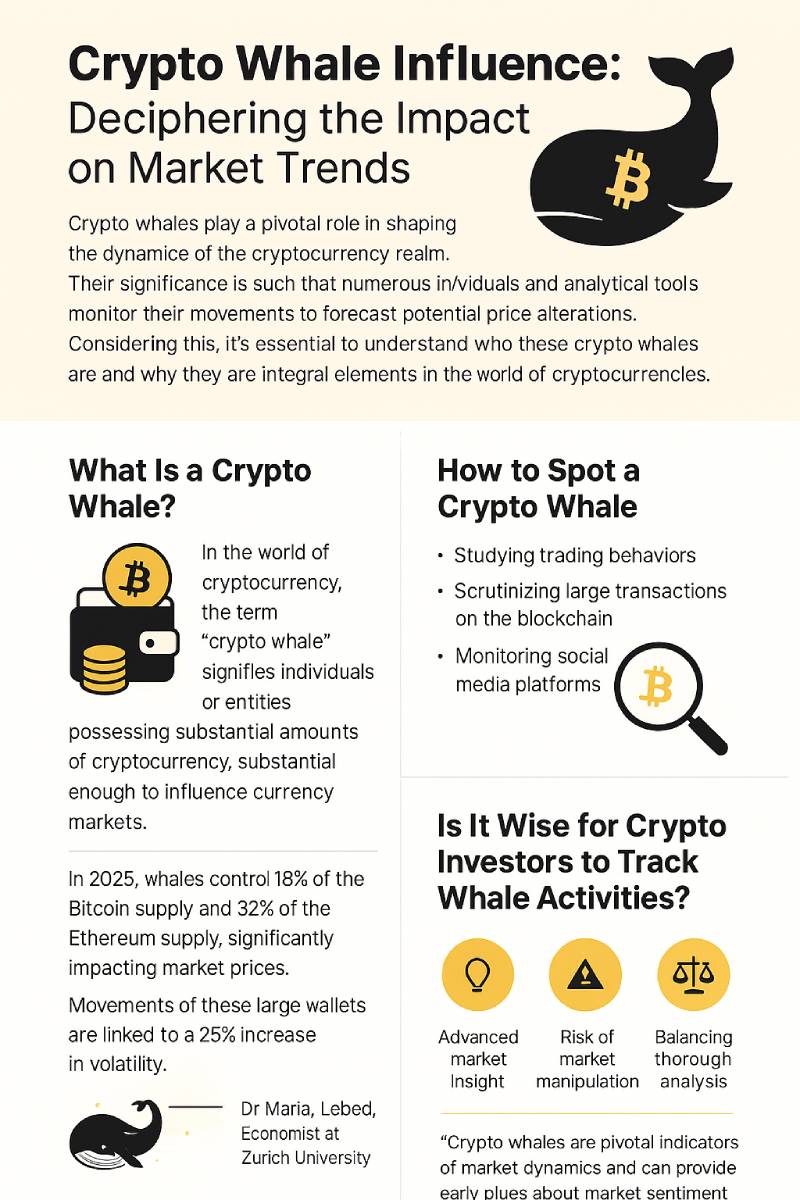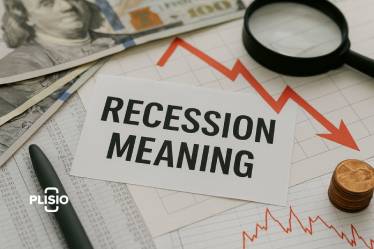Crypto Whale Impact: Understanding Their Effect on Market Movements

Crypto whales are crucial in influencing the interactions within the cryptocurrency market. Their importance is so pronounced that many people and analytical resources track their activities to predict possible price changes. Given this context, it is important to recognize who these crypto whales are and why they are vital components in the cryptocurrency landscape.
What Is a Crypto Whale?
In the world of cryptocurrency, the term “crypto whale” signifies individuals or entities possessing substantial amounts of cryptocurrency, substantial enough to influence the currency markets. Typically, entities owning at least 10 percent of a given cryptocurrency or those with wallets holding more than $10 million in a single cryptocurrency are considered to be whales. For example, in the context of Bitcoin, entities with a minimum of 1,000 BTC fall under this category.
Crypto whales are pivotal actors in the cryptocurrency space, influencing price movements and market stability. They are so influential that their activities are meticulously tracked by various individuals and tools in an attempt to predict price movements and market trends. These entities can significantly sway currency valuations and create price volatility increases, which are keenly observed by other investors and the community at large.
To elaborate, crypto whales can be individuals like Tyler and Cameron Winklevoss, Michael Saylor, and Brian Armstrong, or organizations that own a large quantity of coins or a collection of non-fungible tokens (NFTs). These entities can hold a variety of cryptocurrencies, such as Bitcoin, Ethereum, and other altcoins, or a collection of high-value NFTs like Bored Apes and CryptoPunks.
A recent example occurred in March 2024 when an Ethereum whale transferred 35,000 ETH (valued at over $110 million at the time) to a centralized exchange. This sparked speculation of an impending sell-off and triggered a 6% dip in Ethereum's price within 48 hours. On-chain analysts from Glassnode confirmed the link between the whale’s move and the sudden market reaction.
According to 2026 data from IntoTheBlock, over 42% of all Bitcoin is currently held by wallets containing more than 1,000 BTC. Meanwhile, in Ethereum’s case, whales control approximately 39% of the total supply. These figures highlight the ongoing concentration of assets among large holders, reinforcing their outsized influence on market movements.
The threshold to be considered a whale can vary depending on the cryptocurrency in question due to the differences in market capitalization among different coins. For instance, while $10 million worth of BTC is a threshold for Bitcoin, the minimum requirement may be substantially lower for altcoins, especially those with smaller market capitalization. In the case of coins like Polygon's MATIC or Dogecoin, owning under $1 million might qualify an entity as a whale.
It is important to recognize that crypto whales can create significant fluctuations in the prices of cryptocurrencies or NFTs if they choose to liquidate their assets all at once. Therefore, keeping an eye on their activities is vital for forecasting market trends. They possess the ability to influence market behavior, and their buying and selling strategies are often scrutinized by smaller investors and the broader crypto community.
Additionally, in the context of NFTs, a whale typically refers to an individual or organization that controls a substantial portion of a specific collection. For instance, an entity that owns 50 out of 1,000 NFTs in a collection would likely be regarded as a whale. These individuals or organizations often possess numerous high-value blue-chip NFTs, which constitute major segments of collections and affect the valuation and market dynamics of these digital assets.
In early 2023, a single wallet was revealed to hold nearly 80 Bored Ape NFTs. When this whale sold 10 Apes in a single day, the floor price of the collection dropped by nearly 9%. The NFT analytics platform Nansen flagged the transaction in real-time, prompting traders to brace for additional sell pressure.
Presence and actions of crypto whales play a critical role in the cryptocurrency and NFT marketplaces, affecting prices, volatility, and market perceptions. Understanding their influence and movements is crucial for both individual and institutional investors in navigating the complex landscapes of crypto and NFT investments.
How to Spot a Crypto Whale
Thanks to the fundamental transparency, openness, and permanence of blockchain technology, there are multiple ways to track the activities of cryptocurrency whales. However, spotting whale activity can be quite challenging. Whales often use sophisticated techniques to subtly move their assets, attempting to conceal both their identities and the magnitude of their investments. Nonetheless, there are various indicators that can help in identifying possible movements by crypto whales.
First and foremost, analyzing trading behaviors can be a preliminary approach to identify the activities of large investors, often referred to as whales. These whales can influence the market through large transactions, resulting in sudden price changes. Unusual trading behaviors may indicate the involvement of these whales, and examining them can provide valuable information about potential market strategies employed by these players.
Blockchain explorers like Etherscan or Blockchair enable users to scrutinize large transactions, another method of spotting whales. Observing substantial movements of cryptocurrency may be indicative of whale operations, giving an opportunity to anticipate possible market shifts.
In our own analysis at Plisio Markets, we’ve seen several cases where tracking wallet flows ahead of token listing announcements gave early signals of insider accumulation — an insight only visible thanks to whale-tracking algorithms.
Moreover, monitoring social media platforms, predominantly Twitter, can also be pivotal in tracking whale movements. Crypto whales often disseminate their views on market tendencies, investment approaches, and specific cryptocurrencies via social media. Paying attention to posts and remarks from reputed accounts can provide valuable insights into the strategies and intentions of crypto whales.
While some whales prefer to publicly disclose their holdings and thoughts on social media, others may choose to act under pseudonyms or distribute their assets across multiple wallets to maintain a low profile. This means that vigilance and comprehensive analysis are key in accurately tracing and understanding the impacts of whale activities in the cryptocurrency market.
It’s also imperative to note that tracking the activities of crypto whales can be a valuable strategy for investors looking to align their investment decisions with market trends, as the actions of whales can significantly affect the valuation and liquidity of cryptocurrencies, providing knowledgeable investors with the potential to optimize their trading strategies accordingly.
Why Do Crypto Whales Matter?
Crypto whales hold immense sway in the realm of decentralized finance; a single transaction executed by them can markedly alter the valuation of a particular cryptocurrency. Their substantial holdings mean that any action they undertake—be it purchasing, selling, or trading cryptocurrencies—inevitably reshapes the currency's supply and demand dynamics, subsequently influencing its market price.
Operating typically with millions of dollars, whales' trading activities can induce significant fluctuations in the market, setting trends and signaling shifts in demand. When whales invest in a specific cryptocurrency, it often interprets as a surge in demand for that particular asset within the crypto community, prompting others to follow suit. Conversely, when a whale decides to sell or "liquidate" substantial portions of their holdings, it usually results in heightened price volatility.
The chairman of privacy-centric blockchain Concordium and Saxo Bank founder, Lars Seier Christensen, mentioned, “Given the generally limited liquidity in crypto markets, transactions involving substantial amounts can notably drive prices upwards or downwards. Hence, the movements and trading activities of whales attract considerable attention as they offer clues to prospective price trajectories.”
In late 2022, Plisio analysts observed that a large Bitcoin whale moved over 15,000 BTC to an exchange right before a $2,000 dip in Bitcoin’s price. That transaction became one of the most retweeted alerts on Whale Alert that quarter.
Dr. Maria Lebed, a blockchain economist at the University of Zurich, adds: “Whales serve as both a signal and a stress test for crypto markets. Their movements can catalyze shifts that reveal hidden weaknesses or strengths in a token’s economic structure.”
According to Harry Oak, senior analyst at Plisio Research, “Monitoring whale addresses is not just about speculation. It’s a data-driven approach to gauge market sentiment and risk. In our models, whale accumulation often precedes medium-term upward trends.”
According to data from CoinMetrics and Santiment published in Q1 2026, over 60% of Ethereum’s price spikes above 5% in a 24-hour period were preceded by notable inflows to whale-controlled wallets. Additionally, Bitcoin’s daily volatility remains closely tied to the trading activity of the top 100 wallets, which account for over $380 billion in combined holdings.
It's crucial to understand that the movements and trading behaviors of crypto whales often serve as bellwethers to the broader market and can offer crucial insights to traders and investors seeking to anticipate market trends. In such thin markets where liquidity is premium, the actions of these major players become even more significant, and discerning their potential moves and strategies is crucial for anyone looking to navigate the crypto seas successfully.
Monitoring whale activities has become an essential strategy for participants in the crypto space, allowing them to align their investments and trading strategies with the probable market movements, leveraging the consequent shifts in prices and market dynamics. In this fast-paced and ever-evolving market, staying abreast of the influential players' actions is pivotal for maximizing opportunities and mitigating risks in the decentralized finance landscape.

Observing the Giants: Is it Wise for Crypto Investors to Track Whale Activities?
Tracking the activities of crypto whales can present numerous opportunities for informed trading decisions. The primary benefit is the access to advanced market insight. As the colossal trades made by whales have a significant impact on market trends and asset values, understanding their moves can offer a glimpse into potential market shifts.
When whales begin to offload substantial portions of their holdings, it can sway investor confidence, potentially causing a dip in asset prices. On the flip side, accumulation of assets by whales can indicate a bullish market sentiment, providing an advantage to those who are privy to such activities early on.
Besides revealing market tendencies and offering lucrative opportunities, scrutinizing whale actions can unveil undisclosed information with the potential to influence the market. Observers can discern early signs of developments and adapt their investment strategies accordingly.
For example, a whale, with insider knowledge of a forthcoming alliance between a DeFi entity and a major commercial brand, may acquire an extensive amount of tokens, triggering a surge in asset value. Vigilant investors, noticing this activity, can analyze whether this move is a precursor to the speculated partnership or is driven by different motives.
At Plisio, our editorial team recently tracked unusual inflows into a lesser-known Layer 1 protocol that preceded a 45% price increase following a major exchange listing. Whale behavior, in that instance, served as an early indicator of market-moving news.
However, it’s crucial for investors to not solely depend on the maneuvers of whales, as their activities can sometimes be market manipulations intended to serve their interests. Whales, by accumulating or disposing of assets in substantial volumes, can induce price fluctuations, leaving less informed traders at a disadvantage.
Moreover, the inherent information imbalance poses risks, as whales usually have access to exclusive insights unavailable to the average trader, making comprehensive research indispensable to avoid falling prey to speculative schemes.
Remembering that whales can also act on impulse, devoid of logical assessment, is vital. Blindly mimicking their moves, without substantial investigation, can result in unfavorable investment outcomes. Balancing whale-watching with meticulous analysis ensures informed and rational investment choices, safeguarding interests in the volatile crypto landscape.
Conclusion
Observing the activities of crypto whales can be highly enlightening, aiding in the development of well-informed investment strategies and providing early warnings of possible price fluctuations. It might also unveil privileged insights and information not readily available to the average investor.
However, relying exclusively on monitoring whale activities can be perilous and should not supersede comprehensive analysis of cryptocurrencies and their underlying projects. Investors aspiring to venture into the crypto market should abstain from basing their investment choices solely on the movements of whales. Delving deep into the core aspects of cryptocurrencies, such as their economic models, supply mechanisms, and market liquidity, is paramount for astute decision-making concerning crypto investments.
Focusing on the foundational elements and intrinsic values of tokens, understanding market dynamics, and considering the technological innovations and usability of projects is crucial. Integrating knowledge of whale activities with a profound understanding of the crypto ecosystem will enable investors to navigate through the volatile waters of the crypto market more effectively and securely, optimizing investment outcomes.



